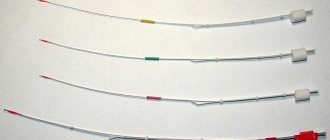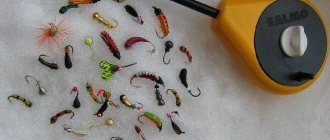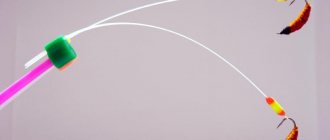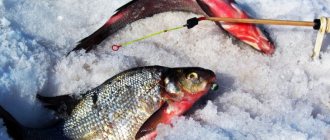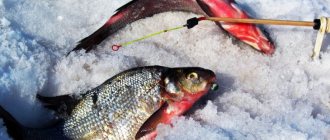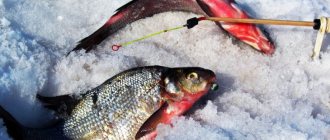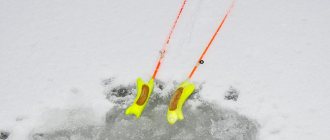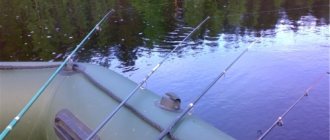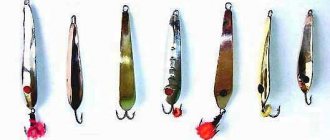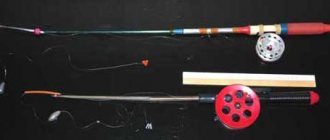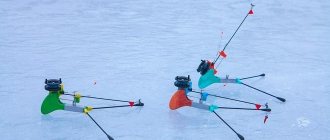I've been using homemade nods for years. My nods are cut from x-ray film and attached to the rod of a fishing rod using a piece of high-voltage automotive wire. X-ray film is not afraid of frost, is plastic and has almost no “memory”.
The car cable has two layers of insulation, between which the nod plate can be secured. Among other things, these materials are available: a car cable can be easily purchased at a spare parts store, and almost every winter fishing enthusiast will have x-rays in his family or, in extreme cases, you can ask at the nearest clinic.
Selecting a jig based on rigidity and angle of inclination
Next in manufacturing comes an important point - you need to test the nod for rigidity. We insert the tip of the hook of the jig into the hole of the plate, for which we make a nod, and evaluate the amount of deflection. Here again you need to take into account the individual preferences of the fisherman regarding the desired amount of deflection.
It is more convenient for me to work with a deflection angle of approximately thirty degrees. If the angle is too small, you should trim the plate slightly with scissors. If the deflection angle is very large, then this plate is not suitable for this jig; you can use it in the design for a lighter jig.
Playing with a jig
The method of playing with a nod depends on the following circumstances:
- what kind of fish is being caught;
- what type of rewinder is used;
- fish activity;
- fishing conditions.
The basic wiring of a nozzle jig is as follows:
- The bait is lowered to the bottom.
- They hit the bottom several times, creating a cloud of turbidity.
- Perform a series of movements of such amplitude and frequency as is required in specific conditions, while slowly raising the jig up.
- They pause, which is often a signal for the fish to attack.
- Raise the jig even higher.
- Repeat the cycle to a certain level.
- The jig is lowered in series to the bottom.
Expert opinion
Knipovich Nikolai Mikhailovich
Zoologist, hydrobiologist. I am interested in fishing at a professional level.
It must be remembered that some fish, especially perch, often remain half-water. Since it is extremely inconvenient to fish while standing with a jig, they wind a certain amount of fishing line onto the reel, trying to roughly notice how much it is in centimeters, and thus fish the middle layers of the water.
When it comes to catching certain types of fish, most anglers know the following:
- perch responds to high-frequency, low-amplitude game;
- bream are seduced by slow play;
- Roach requires a type of game intermediate between those described above.
For those who like to make useful and functional things, a nod from X-ray film is a way to use both the head and the hands, since you need to initially understand how this nod should work.
Making a nod holder from high-voltage automotive wire
We cut off a small piece five millimeters wide from the wire and use an awl to push the core out of it. What remains is a cylinder of double insulation.
Using the tip of scissors, carefully separate the insulation cylinders and insert a film plate between them. We put the entire structure on the rod of the fishing rod. If you do not plan to change the length of the plate, then you can coat it with glue at the junction, although the layers of insulation hold the plate well without this.
We glue a piece of colored cambric onto the top of the workpiece to pass the fishing line, and our DIY X-ray film nod is ready!
We assemble the fishing rod and tie a jig or a jig with a side upper leash. This is what ended up happening.
Comparison of different materials for making a gatehouse
Expert opinion
Knipovich Nikolai Mikhailovich
Zoologist, hydrobiologist. I am interested in fishing at a professional level.
In search of material for making nods for winter fishing rods, fishermen also found their way to old computer keyboards. It turned out that the material inside, astrolon, also fully meets the requirements of fishermen, since its properties are not much different from X-ray film.
A comparison of nods from X-ray and keyboard films is shown in Table 1.
Table 1 - Comparison of nods from X-ray and keyboard films
| Property | X-ray film | Keyboard film |
| Availability | Depends on the capabilities of the fisherman | Depends on the capabilities of the fisherman |
| Ease of manufacture | Same | Same |
| Frost resistance | Higher | Below |
| Sensitivity | Below | Higher |
The fishing line should not be any different
There is an opinion that reelless fishing is sensitive gear, and, therefore, a thin line and light bait are needed. Well, let it be. I don't think this is a rule. I have the thinnest fishing line - 0.128 mm. With baits, I try not to go too small, because I’m always aiming for big fish. All the thinnest and smallest things are useful to me only when participating in competitions, where every gram of fish caught counts.
We invite you to read about cucumbers and tomatoes in one greenhouse
Now my fishing rods are equipped with lines from several manufacturers, but they are all Japanese. I bought my first Japanese fishing line back in 1986, spending my Vneshposyltorg checks, earned in the navy on a long voyage. A couple of skeins with 0.1 mm fishing line are still alive, and every five years I test the new fishing line for strength, comparing it with the first one I acquired as a “boom love”. Then Shimano Silk Shock appeared on sale in our city.
Since I had no doubts about the baits, I wanted to reel in the fishing line “as needed.” But I need one that my friends in Moscow use to catch fish. And they fished with Shimano. Expensive for those times, but I went broke for a couple of splurges. I discovered SunLine fishing line by accident. It was necessary to equip the new fishing rod (by the way, with the first carbon nod) with a good fishing line.
I went to a fishing store and asked for the fishing line of the required diameter and the most expensive one. This keyword made the saleswoman think, rummage through the boxes, on the shelves - and she took out the SunLine Wakasagi fishing line. So, I really liked the fishing line. Holds the load well. We caught carp on the first ice, which, in a half-asleep state, resist at first sluggishly, and then before the hole they begin to make circles.
Wakasagi held both the incessant friction against the ice and the knot. The hooks on the “Devil” unbent, and the 0.123 mm fishing line held it firmly. It is painted in different colors, there are also colorless sections. It is in this place that I tie the bait. At first I tied it just in case - what if the fish got nervous when it saw the fishing line of an unnatural color? And when fishing at great depths, colored fishing line is clearly visible on the ice.
This may seem funny to some, but when you have to put on glasses to thread the fishing line into the loop, then such a subtlety as contrast begins to play a more significant role. Now Wakasagi has been replaced by SunLine FC Sniper BMS. The fishing line color scheme is as follows: colorless piece - 40 cm, orange - 15 cm, colorless again - 40 cm, pink - 15 cm and so on. Thus, it is noticeable on the ice, and there is somewhere to attach the bait, that is, to a colorless area.
In addition, this fluorocarbon has a decent specific gravity, i.e. it sinks quickly. This means that the bait does not lose its weight when immersed. Otherwise, it happens that you lower the “Devil” by 12 m - and you practically stop feeling the bait itself, the nod almost does not bend. The annotation for the fishing line also says that it does not absorb water.
I didn’t observe this with the FC Sniper BMS line: I unwound the fishing rod on the first ice - the line was almost even. Well, specifically for reelless fishing, I think less extensibility is very important. And with a control hook at the top point of the retrieve, which is usually done with the hand, there will be a greater chance of reliably hooking the fish than when using a nylon fishing line.
Well, I already wrote about the wear resistance of fluorocarbon - it really holds up to friction very well. I always use only one knot - the Clinch type, be it a “Goat”, “Devil” or a regular jig. I just make sure that the knot does not rest on any sharp edge, which tungsten lures may well have.
This is the combinatorics
There are many interesting things about winter fishing rods. Some fish with balalaika-type fishing rods, but for others, like me, they don’t fit in the hand. Some fish with long nods, and others with short nods.
Metal nods, lavsan or carbon - all have a right to exist. Each angler chooses all these components for himself - and the result is a bunch of combinations, or rather N to the power of N-1, where N is one of the components of this device.
The more we attach importance to the subtleties of winter fishing gear, the more variations there are. I hope it is now clear that I can only slightly reveal the secret of the values of the variable N, and everyone will be able to compose and then perform combinations or, if you like, variations on the “rewindless” theme. After all, the “mothless device” is a tool for me. Next, I will list four parameters that I consider the most important. Here are 64 options for fishing rods (four to the third power).
How to make it yourself
There are a lot of options for making your own nods for winter fishing. Each homemade lodge has its own characteristics, advantages and disadvantages, and is designed for various fishing methods. Let's look at the most common methods used by most domestic winter fishermen.
From a clock spring
This option for making a bite alarm has long been used by experienced fishermen. This kind of guard is used in reelless fishing, but is most in demand among fans of garland fishing, since it allows you to set the required amplitude and frequency of oscillations of bulky equipment at great depths.
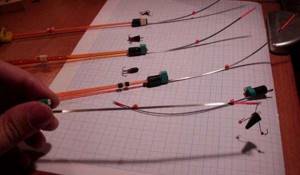
This is what a clock spring nod looks like
To make a nod from a clock spring, you will need the spring itself, soldering supplies, sandpaper and a file, copper or soft steel wire, a ruler, and good scissors to “get rid of” the metal. This bite alarm is made as follows: 1. Cut off about 15 cm of the clock spring and straighten it,
2.Now we cut out a truncated cone from the workpiece so that the width of its upper part is 1.5–2.5 mm,
3. Using a file and sandpaper, we clean all the edges of the future nod,
4.Make a wire loop
Important! The diameter of the loop should not exceed the thickness of the narrow end of the clock spring segment.
5.Using a soldering iron, fix the loop on the narrow end of the nod. We clean off all burrs and roughness.
All that remains is to fix the nod on the rod of the fishing rod. As a rule, this is done using a cambric of the appropriate diameter. You can make a non-adjustable version of the guard, in which it is impossible to move the spring to change its stiffness. You can make it movable, which will allow you to adapt to fishing conditions and give you the opportunity to maneuver on a reservoir, changing both the fishing location and the bait with animation techniques.
From X-ray film
Nods made from X-ray film are extremely sensitive. They are used when fishing with the smallest jigs and allow you to record the slightest contacts of passive, apathetic fish with bait.
To make a nod from X-ray film, you must have the following materials and tools:
- scissors,
- awl,
- X-ray,
- double insulated cable,
- a piece of cambric of small diameter.
To make a nod from X-ray film, we cut out a blank of the required width and length. The optimal shape would be a cone. On one side, using an awl or needle, we make a hole for the fishing line. Now we cut off a piece of insulation about 5–8 mm thick and push the wire out from there.
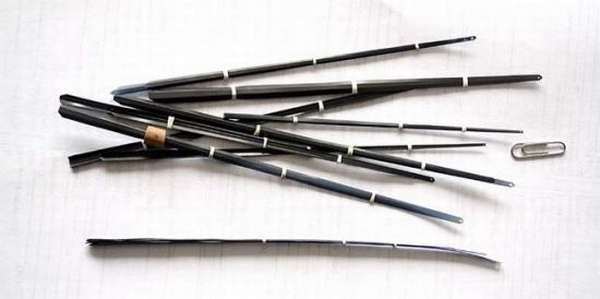
X-ray film nod is suitable for small jigs
We put the insulation on the rod of the rod and insert a cut-out piece of X-ray film into it. All that remains is to use waterproof glue to attach a piece of small-diameter cambric on top of the insulation, into which the fishing line is passed.
From lavsan
A nod made of lavsan or plastic is made similarly to a bite alarm made from x-ray film. It differs in that it allows the production of nods of different rigidity, varying the thickness and rigidity of the material used. The end result is wonderful homemade products for any type of bait, regardless of their weight and fishing method.
Advice! For better contrast of the nod and ease of recording bites, it is advisable to cover its tip with a red waterproof marker.
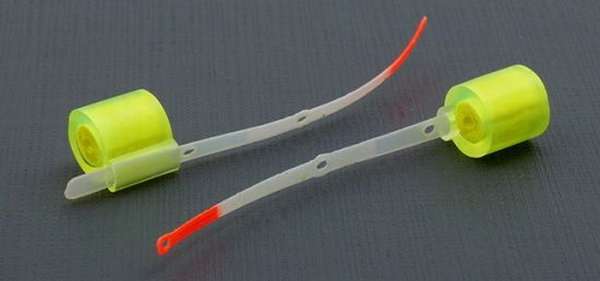
Anyone can make such a nod
Dacron nods from different manufacturers are presented in all fishing stores. These are the most popular bite alarms, which explains their mass production. However, experienced fishermen do not waste their time, but cut out nods themselves, designed to solve specific problems.
Shcherbakov's nod
Shcherbakov's bite alarm is a side nod designed for catching wary fish, in particular bream and large roach. It allows the fish to confidently swallow the bait. This occurs due to the fact that the counterweight, located on one side of the guard, compensates for the weight of the equipment without alerting cautious underwater inhabitants.
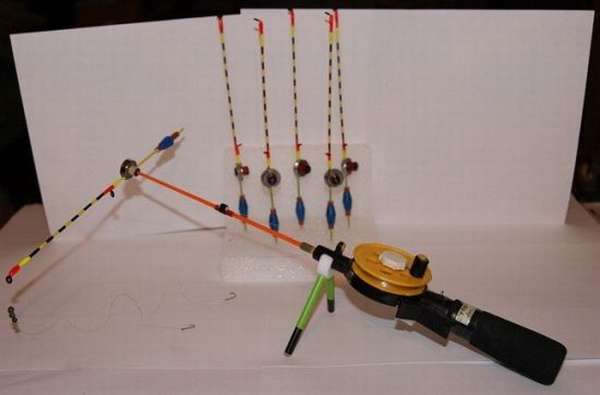
Shcherbakov's hypersensitive arrow nod
Shcherbakov's nod is not produced on an industrial scale, so it is not easy to find it on the shelves of fishing outlets. But you can make it yourself. This is done like this: 1. Take a piece of wire with a diameter of 1.0–1.2 mm and a length of about 25 cm,
2.Somewhere in the middle we wrap the wire around the bearing, prepared in advance for soldering,
3. We reliably solder the connection between the wire and the bearing, clean it from defects, align the wire,
4. On the side that will detect the bite, solder a small ring in the middle. It should be coaxial with the bearing, but look in the opposite direction,
Advice! The ring can be made from ordinary copper or steel wire.
5.For contrast, we put several pieces of bright cambric on the wire, making something like a float,
6.Solder a tulip at the end of the wire or glue it with superglue,
7. All that remains is to put on two pieces of cambric on the other side, and place a counterweight between them.
The resulting nod is suitable for any rod design. With proper balancing of the gear, not a single cautious bite will go unnoticed.
From a coiled spring
A guard made of a twisted spring is usually used for fishing on balance beams. Thanks to the high rigidity, the angler can give the bait the necessary game, and the sensitivity of the nod will ensure good registration of bites and further hooking.
Advice! Similar homemade nods can be found at bird and spontaneous markets, where seasoned fishermen sell products made with their own hands.
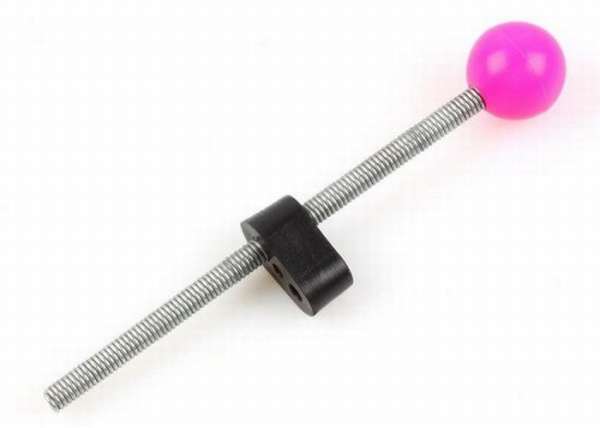
And here is the simplest factory version of a coil spring nod
To make a coil spring nod you will need:
- a coiled spring, which can be obtained from a motorcycle accelerator cable,
- copper wire 0.5–0.8 mm thick,
- cambric,
- sandpaper,
- metal scissors,
- soldering supplies,
- nail polish.
How does a self-hooking fishing rod for winter fishing work?
At first glance, making nods from a coiled spring is not easy, but with some skill you can achieve quite reasonable quality of the guard, which will provide the necessary characteristics of the gear. The manufacturing algorithm for such a bite alarm looks like this:
- Cut a spring about 15 cm long,
- We grind sharp edges and remove roughness,
- We make a loop of copper wire and solder it to the end of the spring,
- We form several more passage rings from the wire and solder them to the spring at an equal distance,
- We clean and polish the soldering areas with sandpaper or a needle file,
- All that remains is to fix the nod using a cambric on the rod's whip.
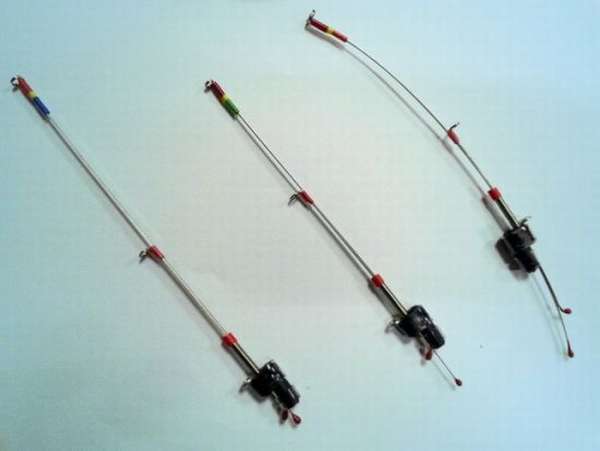
This is what a homemade coil spring nod looks like
All. The guard made of a twisted spring for fishing with balance beams is ready.
Nod "cracker"
This type of bite alarm is usually used in the northern regions when hunting salmon species. It is suitable for fishing for perch and roach using a variety of jigs. Making a clapper nod for a winter fishing rod is quite simple:
- Take a removable whip from a balalaika fishing rod, at the end of which we mount a tulip or a loop made of copper wire,
- In the middle of the six we mount a cambric or a mount from a purchased nod,
- It remains to fix a thin lavsan nod with a length equal to the shoulder from the cambric to the tulip.
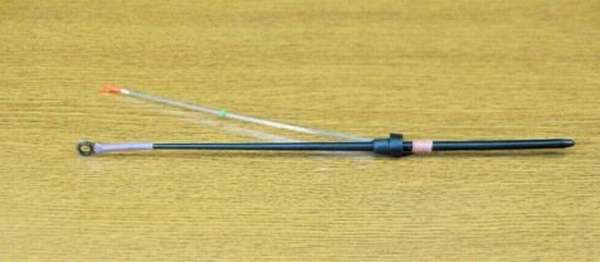
A whip with a clapper can be placed on any balalaika
That's it, the firecracker is ready. It is characterized by high sensitivity and stable operation of the bait. Allows you to catch both passive and active representatives of ichthyofauna.
